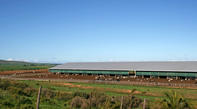A housing system with individual free stalls or cubicles can also be provided as this requires a smaller area of about 10 m2 per animal. This would protect cows against summer heat, wet weather and muddy conditions that may lead to mastitis and foot rot.

Manure runoff can also be controlled. A manure storage pit must be provided to prevent contaminating natural streams. Concrete floors are not a natural surface for dairy cows, therefore cows should have access to a soil based exercise area to allow time off the concrete to prevent hoof problems.
Other facilities include adequate storage space for feeds (hay and concentrates) and an area where feeds can be mixed before feeding. This should be in close proximity to the housing area to reduce labour. An intensive housing system to accommodate all classes of animals for the dairy herd should be designed by an expert on animal housing.
Feed troughs should be on the side of the structure closest to the feed storage area for easy feeding. The layout of the structure depends on prevailing winds (for efficient ventilation) and rainfall.
The movement of the sun should also be considered as cows have to be protected against the sun while feeding at the feed trough. Feed troughs should be on the south side of the building with a sufficient roof overhang to protect feed against rain.
Structures for Milking

A separate dust-free structure (or area) is required for milking cows. In small-scale operations, milking is done either by hand or by using a small transportable milking machine.
Hot and cold running water must be available to wash teats before milking and to wash the milking machine and milk cans after milking. A drying rack for milk cans and space for storing equipment is also required. A large milk vat which can be cooled must be available for milk storage.
By Dr Carel Muller